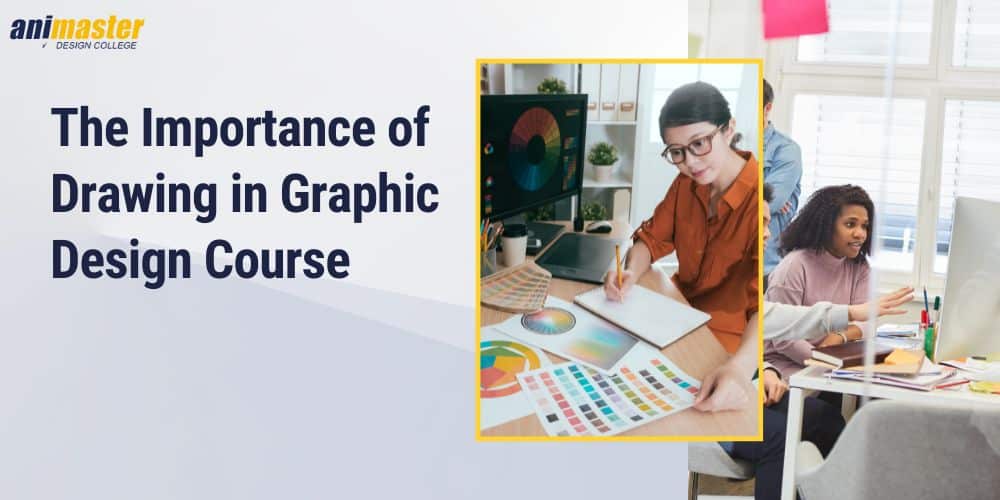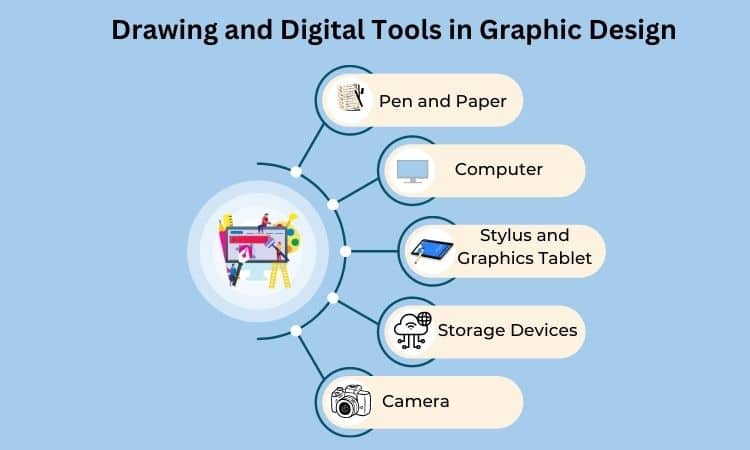
The Importance of Drawing in Graphic Design Course
In today’s digital era, graphic design has become a highly sought-after career. While software and digital tools are prevalent in the field, one fundamental skill remains crucial for every professional graphic designer: drawing. This article explores the pivotal role of drawing in graphic design courses and emphasizes its significance in various aspects of the creative process. Additionally, it discusses the essential tools graphic designers use to enhance their drawing capabilities.
The Role of Drawing in Graphic Design Course
Drawing is the foundation of design, allowing designers to bring their ideas to life. While digital tools help implementation, drawing catalyses creativity and originality. Sketching enables designers to visualize and modify designs, providing a tangible and expressive medium for their imagination. Traditional sketchbooks offer freedom and emotional expression that digital tools may struggle to replicate. By mastering the art of drawing, designers can create blueprints for their designs in physical form and then translate them into digital formats, resulting in more authentic and original designs.
Understanding the Basics of Drawing in Graphic Design Course
To comprehend the significance of drawing in a graphics design course, it is essential to understand the basics of this art form and understand the fundamentals of drawing fully. The following elements play a vital role:
Line
Lines are fundamental in design, adding flow, texture, and emphasis to visual compositions. They can be thick, thin, wavy, or jagged, each imparting a unique feel to the artwork. Lines are used in illustrations and graphic elements such as textures, patterns, and backgrounds. Furthermore, lines contribute to organization, emphasis, and decoration in compositions.
Form
Forms refer to three-dimensional objects or the illusion of depth created through techniques such as light, shadow, and perspective. Forms can be sculptures, architectural structures, or implied objects. They bring realism and depth to the design, enabling designers to create visually appealing and believable representations.
Texture
Texture refers to the physical quality of a surface. It adds depth and tactility to flat images, making objects appear smooth, rough, hard, or soft. By incorporating texture, designers can create visual interest and enhance the overall sensory experience of the artwork.
Balance
Balance is the equal distribution of visual weight, determining how much attention each element attracts. It can be affected by various factors such as color, size, number, and negative space. Achieving balance in design creates a harmonious composition, ensuring the viewer’s eye is guided smoothly across the artwork.
The Technical Benefits of Drawing in Graphic Design
While digital tools have revolutionized the graphic design industry, drawing offers distinct advantages that enhance the creative process. These technical benefits include:
Precision
Drawing with traditional tools allows designers to achieve meticulous precision and attention to detail. Unlike digital precision, traditional drawing provides a tactile experience that enables greater control over fine lines, intricate details, and subtle nuances.
Clarity
Designs created through traditional drawing often exhibit a clarity and visual impact that digital counterparts may need to improve. The organic nature of drawing captures nuances, emotions, and subtle variations that can be challenging to replicate digitally. Traditional artwork can have a raw and authentic quality that resonates with viewers.
Creativity
Drawing tools offer a wide range of possibilities that nurture designers’ unique and imaginative skills. The tactile experience of drawing stimulates creativity and allows for exploring new ideas. By sketching by hand, designers can push boundaries and discover innovative solutions that may be less accessible when working solely with digital tools.
Ability to Transform Thoughts into Reality
Drawing gives designers form and shape to their ideas. It bridges the gap between conceptual thinking and visual representation, allowing designers to convey abstract concepts in a tangible and relatable manner. Drawing helps transform thoughts and imagination into concrete designs, facilitating communication and understanding.
Flexibility
Design software provides flexibility in creating, saving, editing, and resizing designs, enabling productivity and customization. Digital tools allow designers to experiment and iterate rapidly, saving time and effort in the design process. This flexibility empowers designers to explore different artwork variations, styles, and iterations.
Drawing and Digital Tools in Graphic Design
Graphic designers combine traditional and digital tools to create visually compelling artwork. The following tools are essential to learn graphic design.

Pen and Paper
Pen and paper remain the fastest and easiest way to bring ideas into the world. Designers use them to sketch design ideas, jot down notes, and brainstorm concepts. Pen and paper provide a tactile and immediate means of translating thoughts and inspirations into visual form.
Computer
A computer is an indispensable tool for graphic designers. It serves as a platform for running design software and allows for precise digital editing, refining, and polishing of designs. A high-definition monitor enhances the visual clarity and detail of the work.
Stylus and Graphics Tablet
A stylus and graphics tablet provides a digital alternative to traditional pen and paper. They allow designers to work or sketch on a portable device with instant colour, filters, editing, and more features. These tools provide a closer approximation of the tactile experience of traditional drawing while offering the benefits of digital manipulation and versatility.
Storage Devices
Graphic designers work with large files and applications, quickly consuming computer storage. Cloud or physical storage devices ensure sufficient space to store designs, reference materials, and project files securely.
Camera
A high-quality digital camera is essential for graphic designers who incorporate original photos and videos. While smartphone cameras can be used in a pinch, professional designers often invest in DSLR cameras to capture high-resolution images with greater control over settings.
The Future of Drawing in Graphic Design Course
The future of graphics design course will likely witness the influence of emerging technologies and social trends. Automation, artificial intelligence, virtual and augmented reality, and a focus on sustainability and inclusivity are expected to transform the industry. Virtual and augmented reality technologies may enable the creation of immersive and interactive design experiences, blurring the lines between the digital and physical realms. Online Graphic Design courses with Certification, will become increasingly popular for aspiring learners, who like to learn on the go.

Conclusion
Drawing remains an indispensable skill for graphic designers, complementing the advancements in digital tools and technologies. By taking graphic design courses and mastering the art of drawing, designers can harness their creative potential, visualize ideas, refine designs and build a great career in graphic design. Traditional sketching techniques and digital tools enable designers to strike a balance between authenticity, precision, and flexibility. Drawing into the graphic design process fosters originality, enhances creativity, and deepens the understanding of design fundamentals. As such, Drawing gives you a major advantage in graphic design.
FAQs
Q1. Why Is Drawing Important In Graphic Design?
Ans. Drawing allows designers to visualize, alter, and modify designs, providing a foundation for creativity and originality.
Q2. Can I Become A Graphic Designer Without Strong Drawing Skills?
Ans. While strong drawing skills are not mandatory, they greatly enhance a graphic designer’s ability to express ideas and create impactful designs.
Q3. How Can Drawing Enhance Creativity In Design?
Ans. Drawing taps into both the brain’s creative and logical thinking sides, stimulating imagination and offering new perspectives in the design process.
Q4. What Are Some Recommended Drawing Exercises for Graphic Designers?
Ans. Recommended drawing exercises for graphic designers include gesture drawing, contour drawing, and still-life observation.
Q5. Are Digital Drawing Tablets Necessary For Graphic Design?
Ans. Drawing tablets provide precision and control that surpasses standard mice, making them a valuable tool for professional graphic designers.



